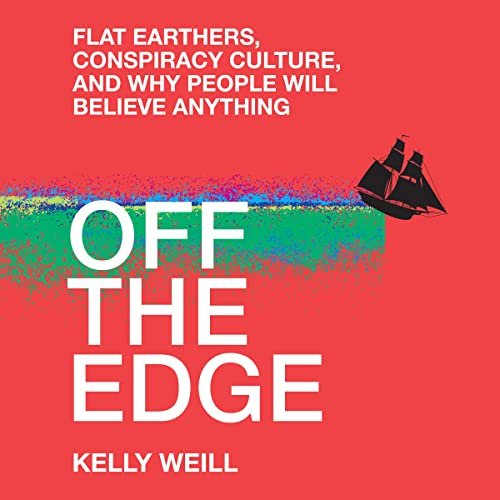People who believe that the earth is flat have been relentlessly mocked for almost 200 years. Yet, believers have been surprisingly resilient despite the ridicule. Why? Because, according to Off the Edge: Flat Earthers, Conspiracy Culture, and Why People Will Believe Anything by Kelly Weill, they are not that much different than the rest of us. (3)
Off the Edge is an engaging study of history and psychology. England in the throes of its own 19th Century Industrial Revolution provides us with the book’s first setting. The rapid growth of factories, cities, and corporations promised great progress, but also threatened the basic fabric of society. Normalcy seemed to me under siege. Utopian movements – promoted by intellectuals ranging from Robert Owen to Karl Marx – emerged to fill a vacuum and right both real and perceived wrongs.
READ: The Important Legacies Of The January 6th Conspiracy
Among the many utopian communities formed in the first half of the 19th Century was one pioneered by Samuel Birley Rowbotham, a poorly educated radical, miracle cure huckster, and Flat Earth founder. Rowbotham offered his followers more than a place to congregate. His beliefs gave them a sanctuary in a world they found increasingly harder to recognize. Flat Earth theory allowed its followers to find traction and a degree of individual power as they were inundated with change on a scale almost beyond their comprehension.
Already, the Flat Earth appeal is starting to make sense in the context of 2023, as we struggle with a new norm that seems to appear almost week-by-week. Not that long ago, artificial intelligence existed as background noise at best. Today, it is revolutionizing how we work, think, and, in my case, teach. We are all looking for traction.
Accompanying the history of Flat Earthers is Weill’s examination of the movement’s psychological appeal. Humans look for patterns, in many cases out of a simple desire to protect themselves. Rob Brotherton’s book Suspicious Minds is an excellent study of just how much our subconscious survival instinct shapes our perception of the world. Flat Earthers embraced the idea and took it much further, however, constructing a pseudointellectual approach to science and nature. Rowbotham promoted the “zetetic” method, which argued that reality was defined only by what you could personally observe with your own senses. (15) If the earth appeared flat to the human eye, it was flat.
READ: The Empty Claims Of ‘2000 Mules’
Reality obviously is more complicated than the zetetic approach would have it. Yet, reality has never deterred Flat Earthers. When their lack of a formal education and mistakes betrayed them – the “zetetic” method was an early casualty of scientific experts – Flat Earth’s acrobatic logic assumed that not only were accepted facts regarding math, geography, physics, or any scientific content irrelevant, they were evidence of a conspiracy of elites determined to peddle the myth that the earth was a globe. (72)
For much of its history, Flat Earth stayed on the margins of society. Samuel Shenton founded the International Flat Earth Research Society (IFERS) in 1956 right at the start of the Space Race. Three years after its creation, the society could claim only 25 members. (62) Despite the fact that tentative space exploration provided more evidence that our planet was a globe, Flat Earthers actually gained sustenance from conspiracies arguing that the moon landing was fake. Even so, by the mid-1970s IFERS had grown to only about 1,000 members worldwide.
Much of this has changed in the recent past. One of the more obvious additions is the internet, but more specifically the algorithms used by platforms like YouTube and Facebook to promote content.(121) In the early days of the world wide web, it was relatively easy for users to unwittingly find unregulated Flat Earth content and their own personal rabbit holes. Few fact checkers stood in anyone’s way, at least initially. Influencers like Mike Adams and Alex Jones, essentially updated versions of old-time hucksters, did not specifically promote Flat Earth theories, but helped them along their way by relentlessly promoting a carousel of conspiracies ranging from Y2K to Sandy Hook. Joining Adams, Jones and their cohort was Donald Trump and a host of public figures who, in a past time, had ignored Flat Earthers. Not anymore. Endorsements from internationally recognized personalities come in the form of tweets and retweets, giving Flat Earthers enormous amounts of oxygen in the social media universe that most of us live in.
READ: Local Journalism Is Critical To Saving Democracy In Our Authoritarian Era
Today’s internet landscape resembles a conspiracy Venn Diagram with overlapping spheres of QAnon, anti-vax, anti-Semitic, neo-Nazi ideology all occupying and competing for the same ground. Flat Earthers live in this environment and, in many important ways, are sustained by it.
As Weill succinctly puts it: “When Earth is flat, other untruths are trivial.” (209) None of the conspiracy movements paralleling Flat Earth are identical but they don’t have to be. All that is required to expand this amalgam of echo chambers is to share some basic features: suspicion of authority, paranoia, selective treatment of evidence, moral righteousness, and an insular approach to the world. These are people with special knowledge on a crusade.
Today, internet skepticism almost always backfires. Critics ranging from online debunkers to late night talk show hosts and even Elon Musk usually succeed in delivering Flat Earth to a larger audience. As Weill points out, Flat Earth proponents readily admit that they have come to depend on media coverage at all levels. (208)
READ: Can Education Solve Our Country’s Conspiracy Theory Problem?
There are many consequences of Flat Earth’s modern evolution, some ridiculous, but most tragic. Rocketeer Mike Hughes famously put his life on the line to pursue his Flat Earth beliefs and died as a result. His homemade projectile was an updated version of Rowbotham’s “zetetic” method and proved to be a spectacular failure. But as Weill points out in her last chapter, the more profound tragedy is in the many personal relationships damaged or destroyed by Flat Earth belief. Winning these lost individuals back resembles deprogramming cult members. Success is uncertain at best. In the meantime, we will have to share reality with a not insignificant number of people who do not believe in it.







